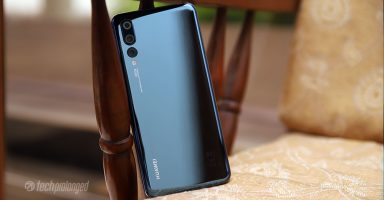Camera - Interface, Image and Video Quality
World’s First Triple Camera
Huawei P20 Pro has a unique triple-camera system which is currently the first attempt to do something which, if one dual-cam could do, other could not.
There were two major setups of dual-cameras as far now. One setup is what Huawei initially brought with Huawei P9 as a monochrome sensor would help improve image detail and provide depth mapping. The other setup features a secondary camera with a telephoto lens to take distant photos with optical zoom. P20 Pro’s triple-camera setup combines both the setups and offers all those features in one package. Here is a quick look at the camera specs.
- 40MP RGB: Main camera with large 1/1.7″ color sensor with quad-bayer structure. It captures more light with f/1.8 aperture lens.
- 20MP B&W: Secondary camera with monochrome sensor to help improve image detail and provide depth information to simulate bokeh effect.
- 8MP Telephoto: A third camera with 80mm equivalent 3x optical zoom tele-lens and features OIS.
Read: Huawei P20 Pro In-Depth Camera Review
Huawei has completely overhauled the native camera user interface to no my likes. This new UI has lot more detail, but all in one row. You can’t switch to a certain mode with just one or two taps. Unlike the three-windowed interface Huawei used in its camera UI that let you swipe-left for settings or swipe-right for all modes. Now everything is on the slider, you move it left or move it right.
The problem is you have to move the whole slider to reach the mode at the end. There is now a gear icon on top right corner which will be available for each mode for its settings. While Huawei offered a lot of modes in its modes-window, thankfully Huawei didn’t put them all in the slider. There is “More” option far right on the slider that would bring the same modes-window with remaining modes.
Still Photos mode offers to shoot with auto/forced flash and always-on flashlight. Live photos or “Moving pictures” as Huawei calls it is also present that records a few seconds before you take the shot. Color modes – standard, vivid, or smooth, options are available in most modes.
By default, the camera is set to take 10MP shots as this is the recommended resolution which you’d mostly want to use with all the available features – such as brilliant optical zoom. Check camera review for detail.
P20 Pro can record videos up to UHD 4K resolution at 30fps and 1080p at 60fps, however the stabilizer is only available up to 1080p 30fps video recording.
Most importantly there is so far the only night time shooter in an impressive way among smartphone, that is P20 Pro. While you can always use “Pro” mode for such situations but a specific “Night” mode offers you to straight out of the box option to take shots in darkest environment. The mode can work impressively when hand-held if you try to keep yourself steady. It takes a 5 sec exposure at lowest possible ISO sensitivity according to the scene. You can choose your own exposure time and ISO as well in this mode. Just for a reference ta look at the following shot.
Huawei’s Master AI is still present and has improved to identify 19 different categories – Mate 10 identified 14 scenes. The categories, P20 Pro can identify, include cat, food, group, natural colours, close-up, night shot, text, greenery, portrait, dog, fireworks, blue sky, flowers, stage, document, sunset, snow, waterfall, and beach.
P20 Pro offers 3D Portrait Lighting driven by the on-board AI. It uses “3D facial modeling tech to follow the contours of your features and adjusts for most flattering selfies.” The system also also provides a set of six types of studio lighting effects and turns your selfies into good looking portraits.
With this interface, Huawei has provided separate modes – one “Portrait” to take shots of people with a few additional options like above studio-lighting. The other “Aperture” mode is separated to take shots of still objects. Both simulate blur background but the level of aperture can only be changed in “Aperture” mode.
Read: Full Camera Review of P20 Pro Published Separately
You should head over to the in-depth camera review of Huawei P20 Pro, however here are a few photos that you will go in detail with our full review.




















